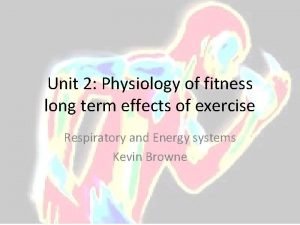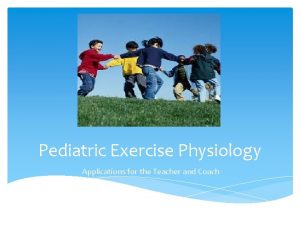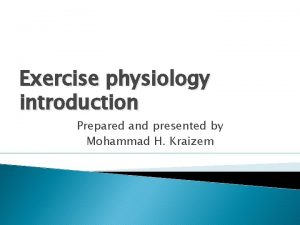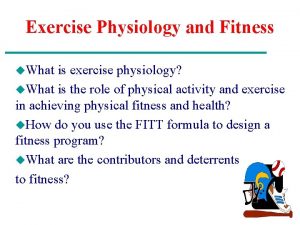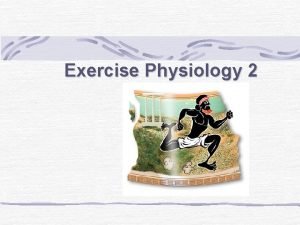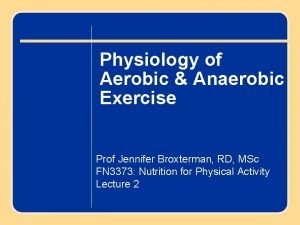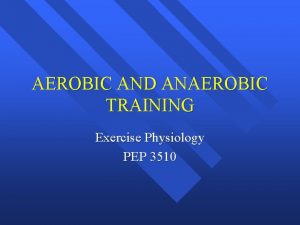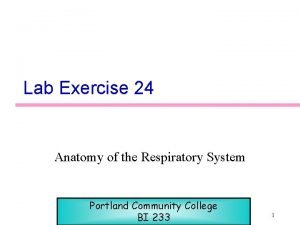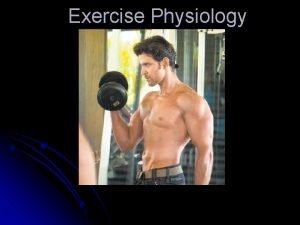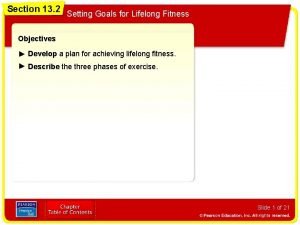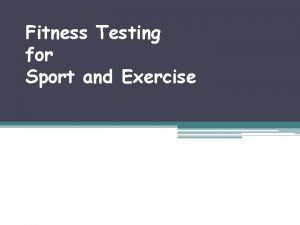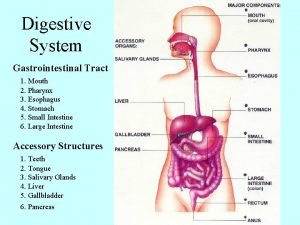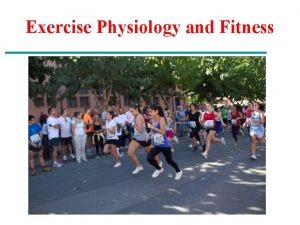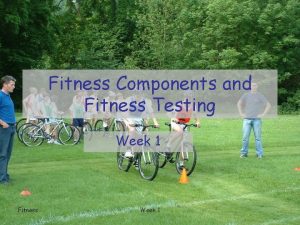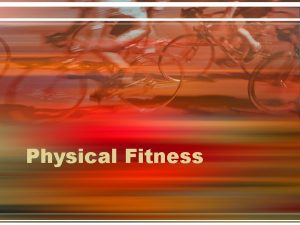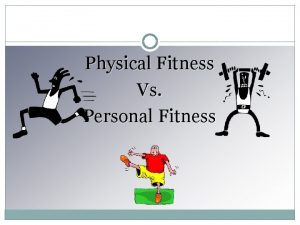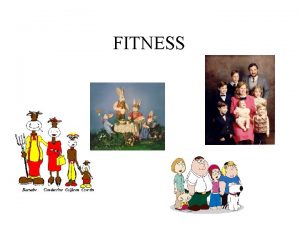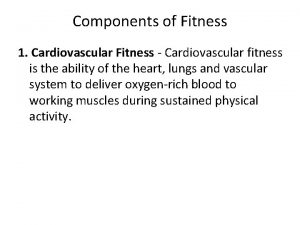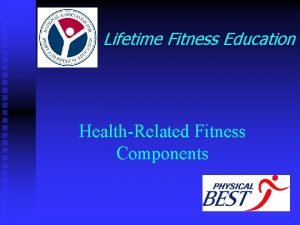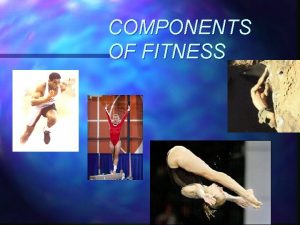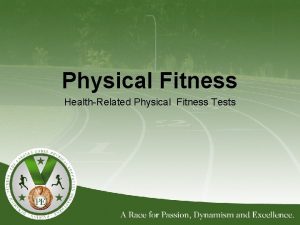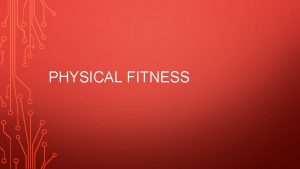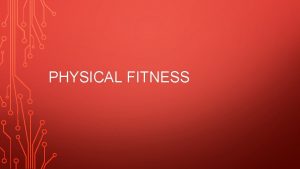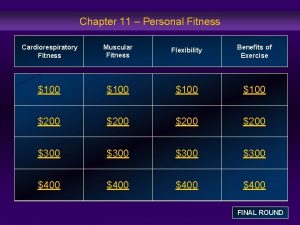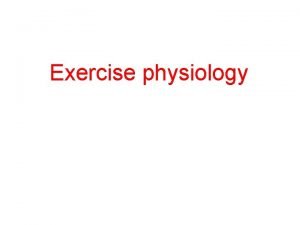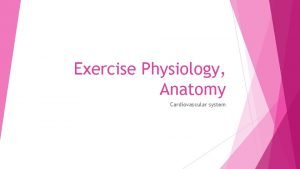Exercise Physiology and Fitness u What is exercise





























































- Slides: 61

Exercise Physiology and Fitness u. What is exercise physiology? u. What is the role of physical activity and exercise in achieving physical fitness and health? u. How do you use the FITT formula to design a fitness program? u. What are the contributors and deterrents to fitness?

Exercise Physiology u The study of the effects of exercise on the body. u Body’s responses and adaptations to exercises ä System to subcellular level ä Acute (short term) to chronic (long term) adaptations u Population served ä Elite performer ä People of all ages and abilities

Historical Development u Specialized area of study mid 1960 s and 1970 s. u Late 1800 s, the use of anthropometry to measure changes in students’ development after training programs. u Mc. Kenzie: Investigating effects of exercise on various systems of the body and the idea of preventative medicine (early 1900 s) u After WWII: increased interest in fitness as a result of youth fitness tests and the results of the physicals of men in the military.

Historical Development u 1970 s: American Physiological Society recognized exercise physiology as a specialized area of physiology. u 1974: ACSM: Guidelines for Graded Exercise Testing and Prescription u 1980 s and 1990 s: Understanding of the relationship between physical activity and health. ä 1996: u 2000: 1 st certification exams for Clinical Exercise Physiologists u Healthy People 2010

Areas of Study u Effects of various exercises on various systems of the body u Relationship of energy metabolism to performance u Effectiveness of training programs u Effects of environmental factors u Effects of individual differences on fitness development and performance

Areas of Study u Identification of factors that limit performance u Effectiveness of various rehabilitation programs u Ergogenic aids and exercise u Health and therapeutic effects associated with exercise u Effects of nutrition on performance

Specialization u Cardiac rehabilitation ä Assessment of cardiovascular functioning ä Prevention of cardiovascular disease ä Rehabilitation of individuals with the disease u Exercise biochemistry ä Effects of exercise at the cellular level ä Exercise epidemiology: Relationship between physical activity and mortality ä Pediatric exercise science: Scientific study of the response of the body to exercise during childhood and maturation.

Physical Fitness u Ability of the body’s systems to function efficiently and effectively. u One is “physically fit” if they have the ability to: ä “carry out daily tasks with vigor and alertness, without undue fatigue, and with ample energy to enjoy leisure-time pursuits and to meet unforeseen emergencies. ”

Physical Fitness u Health fitness ä Body composition ä Cardiorespiratory endurance ä Flexibility ä Muscular endurance ä Muscular strength u Performance or skillrelated fitness ä Agility ä Balance ä Coordination ä Power ä Reaction Time ä Speed

Physical Activity, Physical Fitness, and Health u Hypokinetic diseases ä Diseases caused by insufficient physical activity, often in conjunction with inappropriate dietary practices. u Dose-response debate ä What kind of activity? ä How much time spent in activity? ä At what intensity should it be performed? ä How often in order to see benefits?

Physical Activity and Health u 1996: : ä “Individuals who engage in moderate intensity exercise for at least 30 minutes for most, or preferably all, days of the week, can improve their health and decrease their risk for disease. ”

Health Benefits u Enhanced cardiovascular function u Reduction of many cardiovascular disease risk factors u Increase ability to perform tasks of daily living u Reduced risk of muscle and joint injury u Improved work performance u Improved physical appearance, self-image, and sound mental health

Health Benefits u Reduction of susceptibility to depression and anxiety u Management of stress u Enhancement of self-concept and esteem u Socialization through participation in physical activities u Improved overall general motor performance u Energy u Resistance to fatigue u Reduce the debilitating effects of old-age or retain a more desirable level of health for a longer period of time

Energy Production for Physical Activity u Use of ATP as energy to perform muscular activity. Two ways to produce ATP: u Anaerobic system ä Without oxygen ä High energy expenditure, short time (6 -60 seconds) u Aerobic system ä With oxygen ä Lower rate of energy expenditure, longer period of time (more than 3 minutes)

Principles of Fitness Training u Principle of overload ä To improve, one must perform more than one’s normal amount of exercise. u Principle of specificity ä Programs should be designed in relation to specific goals in mind. u Individual’s initial fitness level ä Assess initial level of fitness to design realistic program and a starting point. u Progression of program ä Increase program as individual becomes adjusted.

Principles of Fitness Training u Individual differences ä Individual’s work, diet, lifestyle, and management of stress should be taken into consideration. u Warm-up, workout, cooldown components ä Helps prevent injury and prepares body for exercise as well as returns it to a normal state. u Safety ä Information collected from medical screening, and informing individual of environmental conditions u Behavioral factors ä Motivation of individual to adhere to fitness program

Planning a Fitness Program u Threshold of training ä Minimal level of exercise needed to achieve desired benefits. u Target zone ä Defines the upper limits of training and the optimal level of exercise. u FITT formula ä Frequency, Intensity, Time, and Type ä Manipulate these factors to produce an individualized exercise program. u Needs and goals of individual ä Program should meet the goals of the individual

FITT formula u Frequency ä Number of sessions each week u Intensity ä Degree of effort put forth by the individual during exercise. u Time ä Duration of activity u Type ä Mode of exercise being performed

Cardiorespiratory Endurance u Body’s ability to deliver oxygen effectively to the working muscles to perform physical activity. u Most important component of health fitness. u Helps prevent hypokinetic disease. u Concerned with the aerobic efficiency of the body.

Cardiorespiratory Endurance u Frequency: u Intensity: u Time: u Type: – – – – 3 to 5 times per week 60% to 90% HRMAX 20 - 30 minutes Aerobic activities Jogging Running Walking Dancing Cross Country Skiing Biking Swimming

Target Zone u HRMAX=220 bpm - age u Target zone = 60% to 90% HRMAX u Lower threshold target HR= HRMAX x 60% u Upper threshold target HR= HRMAX x 90% u Calculations for a 20 -year-old ä HRMAX =220 -20=200 bpm ä Lower threshold = 200 bpm x 60%=120 bpm ä Upper threshold = 200 bpm x 90%=180 bpm

Body Composition u Percentage of body weight composed of fat as compared with fat-free or lean tissue. ä Determined by height and weight tables or BMI u Obesity is associated with numerous health problems and earlier mortality. ä In 1999, and estimated 61% of adults were either overweight or obese, and 13% of children were overweight. u Determination important. of the cause of obesity is

Body Composition u Body composition is primarily influenced by nutrition and physical activity. u Energy balance is important to achieving a favorable body composition. u Energy expenditure through: ä basal metabolism (maintenance of essential life functions) ä work (including exercise) ä excretion of body wastes

Body Composition

Energy Balance u Number of calories taken into the body as food Number of calories expended Energy or caloric balance u Caloric expenditure ä Neutral balance » Caloric intake equals expenditure. ä Positive balance » More calories consumed than expended. ä Negative balance » More calories are expended than consumed. -

Body Composition Improvement u Decreasing percentage of fat ä Decrease caloric intake through diet. ä Increase caloric expenditure through physical activity and exercise. ä Moderate decrease in caloric intake and moderate increase in caloric expenditure.

Measurement of Body Composition u Hydrostatic weighing u Skinfold measurements ä Skinfold caliper from selected sites ä Use of formulas to calculate percentage of body fat u Body mass index (BMI) ä height-to-weight ratio

Muscular Strength and Endurance u Muscular strength is the ability of a muscle or a muscle group to exert a single force against a resistance. u Muscular endurance is the ability of a muscle or muscle group to exert force repeatedly or over a period of time. u Maintenance of proper posture; protect joints. u Production of power to enhance performance.

Exercises u Isometric exercises ä Muscle exerts force against an immovable object. ä Static contraction u Isotonic exercises ä Force is generated while the muscle is changing in length. ä Concentric and Eccentric contractions u Isokinetic exercises ä Contractions are performed at a constant velocity. ä Cybex and Orthotron machines

Development of Muscular Strength and Endurance u Principle of Overload is critical. u Repetition is the performance of a movement through the full range of motion. u Set is the number of repetitions of performed without rest. u Strength ä Low number of repetitions with a heavy resistance. u Endurance ä High number of repetitions with a low resistance. u FITT

Flexibility u Maximum range of motion possible at a joint u Joint specific: better range of motion in some joints than in others. u Can prevent muscle injuries; improve low-back pain u Decreased flexibility can be caused by: ä Sedentary lifestyle ä Age ä High amounts of body fat ä Stress

Flexibility u Improvement of flexibility ä Ballistic stretching » Momentum generated from repeated bouncing to stretch. » Not recommended- may overstretch the muscle. ä Static stretching » Slowly moving into a stretching position and holding for a certain period of time (10 -30 seconds; 5 times). ä Contract-relax technique » Relaxing of the muscle to be stretched by contracting the opposite muscle (hamstrings/quadriceps) u Measurement of flexibility-goniometer

Conducting Fitness Programs u Provide for cognitive and affective goals as well as physical activity. u Make fitness enjoyable. u Establish goals and a plan of action to attain them. u Monitor progress. u Provide for maintenance of fitness. u Fitness requires personal commitment.

Effects of Training Lower oxygen consumption Lower pulse rate Larger stroke volume Lower rise in blood pressure Slower respiration rate Lower rate of lactic acid formation Faster return to “normal”

Effects of Training Greater cardiorespiratory efficiency. Greater endurance. More “work” can be performed at less cost. Improvement in fitness components. Coordination and timing of movements are better.

Physical Activity & Health u Adults - 30 minutes of physical activity equal to brisk walking on most, preferably all, days of the week. u Activity of greater intensity will yield greater health benefits. u Strength-developing activities at least twice a week.

Environmental Considerations u Hot and humid weather ä Use extreme caution ä Heat cramps, heat exhaustion, heat stroke ä Fluid replacement ä Adaptation u Extreme cold weather ä Heat conservation ä Hypothermia ä Frostbite

Nutrition and Fitness u Nutrients ä carbohydrates ä fats ä proteins ä vitamins ä minerals ä water u Maintaining water balance is important. u A well-balanced diet is necessary to obtain all the nutrients required by the body.

Nutrition u Food pyramid offers guidelines for eating a balanced diet. u Current U. S. diet is too high in fat, cholesterol, sugar, and sodium and lacking in carbohydrates and fiber. u Carefully monitor caloric intake AND caloric expenditure. u Special diets for special situations.

Dietary Guidelines for Americans, 2000 u Aim For Fitness ä Aim for a healthy weight. ä Be physically active each day. u Build A Healthy Base ä Let the Pyramid guide your food choices. ä Eat a variety of grains, fruits, and vegetables daily. ä Keep food safe to eat. u Choose Sensibly ä Choose a diet low in saturated fat, cholesterol, and moderate in total fat. ä Choose beverages and foods to moderate intake of sugars. ä Choose and prepare foods with less salt. ä Drink alcoholic beverages in moderation.

Stress Management u Stress is the body’s physiological response to demands placed on it. u Nature of stressors (physical or cognitive) u Nature of stress response (“fight or flight”) u The critical role of perception in interpretation and management of stress u Stress and its role in disease ä Coronary heart disease, cancer, hypertension, eating disorders, depression, etc.

Stress Management u Use stress to your advantage u Approaches to manage stress ä Relaxation training ä Physical activity ä Cognitive strategies ä Time management ä Biofeedback u Physical fitness contributes to stress resistance

Deterrents to Fitness u Dietary practices u Tobacco u Excessive alcohol consumption u Use of drugs u Inappropriate stress management approaches

Tobacco and Fitness u u u u Over 430, 000 premature deaths/ year are related to smoking. 25% of adults smoke. Children and teens constitute 90% of the new smokers. Average of starting is 13. Second hand smoke contributes to 3, 000 deaths of nonsmokers each year. Significant role in all cancers. Detracts from fitness

Drug Abuse u Use of an illicit drug or use of a legal drug in a manner that is harmful to health and well-being. u Psychoactive drugs are most frequently abused. ä Those that alter one’s behaviors, feelings, and perceptions. u Development of dependence. u Health risks associated with drug abuse. u Death as a result of overdose of severe reaction.

Alcohol and Fitness u Impact of alcohol on physical and psychological state, therefore it is a drug. ä Liver damage, cardiovascular disease ä CNS impairment, malnutrition ä Fetal Alcohol Syndrome ä Negatively affects one’s body composition

The Energy Systems � 3 � energy pathways Anaerobic pathways: phosphagen and glycolytic Do not require oxygen � Occurs in cell’s cytoplasm � Phosphagen pathway � � Phosphate molecule is transferred to ADP to make ATP �Glycolytic � � � pathway Requires more steps, involves the breakdown of a glucose to produce ATP. Results in formation of ATP and pyruvate Not useful for prolonged exercise

The Energy Systems � 3 � energy pathways Aerobic pathway: oxidative pathway Oxidation occurs in mitochondria � Requires oxygen � Glycolysis and Kreb’s cycle oxidizes glucose (from carbohydrate) or fatty acid (breakdown of stored fat) and is completed with the electron transport chain to produce ATP � Provides energy for endurance activities �

The Energy Systems � Exercise � � � Training Specific energy pathways in the muscle can be enhance with training Anaerobic (sprint) training increase cell’s ability to produce energy from the phosphagen and glycolytic pathways Aerobic (endurance) training will increase the ability to synthesize ATP via oxidation Will increase muscle glycogen concentration � Enhance ability of muscle to resist fatigue during prolonged exercise �

�Hormones � � � and exercise The Endocrine System Pituitary gland � With exercise secretes growth hormone which influences fuel use with exercise � And antidiuretic hormone will increase water conservation during exercise Adrenal gland � Cortex secretes cortisol and alodosterone � Medulla secretes epinephrine (adrenaline) and norepinephrine (noradrenaline) Pancreas � Secretes insulin hormone in response to increase blood glucose levels � Exercise causes insulin levels to decline �Secretes glucagon hormone when there is a decrease blood glucose levels � Glucagon increases the amount of glucose formed and released by the liver

The Endocrine System � Exercise training response to the endocrine system � Endurance training � � Reduce the release of epinephrine & norepinephrine Resistance training May influence the body’s response to the hormones testosterone, insulin-like growth factor-I, and cortisol � Due to increase muscle mass �

The Skeletal Muscle System Comprises 40% of total body mass � Together with nervous system, provides movement � Functional unit of muscle is the muscle fiber � Single muscle fiber is comprised of sacromeres � Sacromeres contain the contractile elements actin and myosin � Once activated by neural stimulation, myosin and actin filaments attach and pull toward the sacromere � Then, muscle fiber shortens and force is generated �

The Skeletal Muscle System � Human skeletal muscle is comprised of 3 different types of fibers � Slow twitch (Type I) � � � Good endurance Reliance on oxidative metabolism to produce ATP Fast twitch (Type IIa) Combination of good endurance and power Fast twitch b (Type IIb) Most powerful fibers, poor endurance

Skeletal Muscle Fiber Type Classification Schemes Twitch Term Energetic Term Color Term Generic Term Slow twitch (ST) Red Type I Slow, oxidative (SO) Fast twitch a (FTa) Fast, oxidative, glycolytic (FOG) Intermediate Type IIa Fast twitch b (FTb) Fast glycolytic (FG) White Type IIb

The Skeletal Muscle System � Exercise training response can impact system � Aerobic training � � Will increase endurance capacity of all three fiber types Strength training � Will not change muscle fiber but will result in increase in strength due to increase in muscle mass

The Cardiovascular System � Delivers oxygen and nutrients and removes carbon dioxide � Consists of heart, blood vessels and blood � Exercise will affect each component � HR x SV = Q � � � Exercise increases Q Increase in Q and HR directly proportional to exercise intensity Increase in Q increase BP

The Cardiovascular System � HR—heart rate � SV—stroke volume �Amount of blood pumped out of heart with each beat � Q—cardiac output � Vasoconstriction occurs in arterial blood vessels in viscera � Vasodilation occurs in blood vessels of working skeletal muscles � This causes changes in blood flow patterns, shunting more blood to working skeletal muscles

The Cardiovascular System � Exercise � training response Aerobic training Heart pumps stronger � Blood volume expands � Increase in capillaries � Submaximal exercise: HR decreases and SV increases � Maximal exercise: HR unchanged or decreases, SV increases, Q increases �

The Respiratory System � Lungs responsible for ventilation and diffusion � Comprised of lungs and airways that conduct air flow into the lungs � Ventilation—process of drawing air into the lungs � Diffusion—process of oxygen and carbon dioxide are exchanged between blood and alveoli (inner most region of lung)

The Respiratory System � Airways that conduct air in and out of lungs dilate, this reduces resistance to air flow. � Additional airways open and increases ventilation � Diffusion of oxygen and carbon dioxide between alveoli and capillaries occurs due to pressure differences

The Respiratory System � Exercise � training responses Aerobic training Increase maximal capacity of lungs to increase tidal volume and respiratory rate � Training will enhance the rate of oxygen diffusion out of the lungs and into the blood � Respiratory system and cardiovascular system both increase capacity with increasing exercise intensities �
 Exercise physiology for health, fitness, and performance
Exercise physiology for health, fitness, and performance Unit 2 physiology of fitness
Unit 2 physiology of fitness Health related fitness and skill related fitness
Health related fitness and skill related fitness Physiology of sport and exercise 5th edition
Physiology of sport and exercise 5th edition Pediatric exercise physiology
Pediatric exercise physiology Define exercise physiology
Define exercise physiology Meaning of exercise physiology
Meaning of exercise physiology 2 types of exercise
2 types of exercise Myeloma uk forum
Myeloma uk forum Anaerobic exercise physiology
Anaerobic exercise physiology Pep 3510a
Pep 3510a Exercise physiology quiz
Exercise physiology quiz Exercise 24 review sheet respiratory system physiology
Exercise 24 review sheet respiratory system physiology Co=map/tpr
Co=map/tpr Lifelong fitness formula
Lifelong fitness formula Fitness testing for sport and exercise
Fitness testing for sport and exercise Parts of the upper respiratory tract
Parts of the upper respiratory tract Tattoo anatomy and physiology
Tattoo anatomy and physiology Anatomy science olympiad
Anatomy science olympiad Perfect vs imperfect flower
Perfect vs imperfect flower Bone metabolism
Bone metabolism Anatomy and physiology of gastritis
Anatomy and physiology of gastritis Microbial physiology notes
Microbial physiology notes Cantlie line
Cantlie line Epigastric region
Epigastric region Wpigastric region
Wpigastric region Google.com
Google.com The central sulcus divides which two lobes? (figure 14-13)
The central sulcus divides which two lobes? (figure 14-13) Endomysium
Endomysium What is mouth in digestive system
What is mouth in digestive system Http://anatomy and physiology
Http://anatomy and physiology Waistline
Waistline Appendicitis anatomy and physiology
Appendicitis anatomy and physiology Aohs foundations of anatomy and physiology 1
Aohs foundations of anatomy and physiology 1 Aohs foundations of anatomy and physiology 1
Aohs foundations of anatomy and physiology 1 Anatomy and physiology of swine
Anatomy and physiology of swine Anatomy and physiology chapter 8 special senses
Anatomy and physiology chapter 8 special senses Chapter 13 anatomy and physiology of pregnancy
Chapter 13 anatomy and physiology of pregnancy Unit 26 animal anatomy physiology and nutrition
Unit 26 animal anatomy physiology and nutrition Science olympiad forensics cheat sheet
Science olympiad forensics cheat sheet Anatomy and physiology chapter 2
Anatomy and physiology chapter 2 Stomach anatomy and physiology ppt
Stomach anatomy and physiology ppt Anatomy and physiology of diabetes
Anatomy and physiology of diabetes Chapter 7:9 lymphatic system
Chapter 7:9 lymphatic system Anatomy and physiology coloring workbook chapter 14
Anatomy and physiology coloring workbook chapter 14 Chapter 10 blood anatomy and physiology
Chapter 10 blood anatomy and physiology Aohs foundations of anatomy and physiology 1
Aohs foundations of anatomy and physiology 1 Aohs foundations of anatomy and physiology 1
Aohs foundations of anatomy and physiology 1 What produces bile
What produces bile Anatomy and physiology chapter 15
Anatomy and physiology chapter 15 Cornell notes for anatomy and physiology
Cornell notes for anatomy and physiology Human anatomy & physiology edition 9
Human anatomy & physiology edition 9 Necessary life functions anatomy and physiology
Necessary life functions anatomy and physiology Holes anatomy and physiology chapter 1
Holes anatomy and physiology chapter 1 Holes essential of human anatomy and physiology
Holes essential of human anatomy and physiology Anatomy and physiology unit 7 cardiovascular system
Anatomy and physiology unit 7 cardiovascular system Gi tract histology
Gi tract histology Anatomy and physiology
Anatomy and physiology Anterior posterior distal proximal
Anterior posterior distal proximal The speed at which the body consumes energy
The speed at which the body consumes energy Aohs foundations of anatomy and physiology 1
Aohs foundations of anatomy and physiology 1 2012 pearson education inc anatomy and physiology
2012 pearson education inc anatomy and physiology

